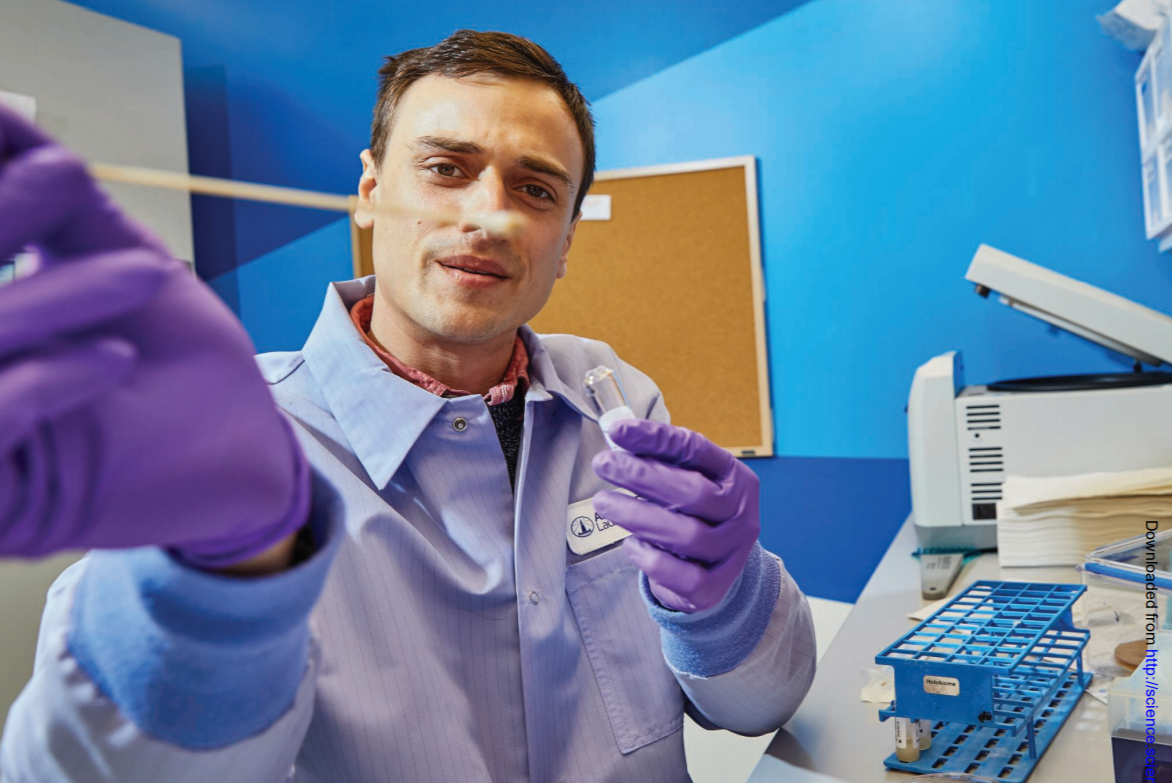每日外闻97

现如今人类肠道微生物的研究是一个科研的热点,应用研究也越来越多,随之也衍生了很多相关的科技公司。
Katya Gavrish正在一个似乎不太可能的地方::人类粪便样本中寻找新的治疗脑部疾病的药物。她是一位认真而专注的微生物学家,曾在俄罗斯接受过培训并且热爱古典音乐,她在一家小型创业公司Holobiome实验室工作,分离和培养细菌样本,Gavrish和她的Holobiome同事希望这些细菌能够为抑郁症以及其他大脑和神经系统疾病提供新的治疗方法。
这家八人公司计划利用流行病学和动物研究中越来越多的证据,将肠道细菌与自闭症、焦虑和阿尔茨海默氏症等多种疾病联系起来。自5年前成立以来,Holobiome已经创造了世界上最大的人类肠道微生物群之一。该公司的首席执行官菲尔·斯特兰德维茨还不能确切地说出新疗法的具体形式。但目标疾病包括抑郁、失眠以及便秘,以及内脏疼痛,比如肠易激综合症的典型症状,这种症状可能与神经系统和肠道关联。斯特兰德维茨拥有微生物学博士学位,他不太喜欢幻想,但也不缺乏雄心壮志:他预测第一个人体试验将在一年内开始。
神经精神疾病的药物开发已经滞后了几十年,而且许多现有的药物并不是对所有的病人都有效,而且还会产生不必要的副作用。有肠道微生物与精神疾病研究领域的专家表示:“这是一个非常年轻、非常令人兴奋的领域,有巨大的潜力。”
一些研究人员更喜欢一种不那么匆忙的方式,专注于了解潜在的生物学原理。但是Holobiome和其他几家公司都渴望在这个蓬勃发展的数十亿美元的市场中获利,这个市场已经出现了其他微生物疗法,其目标是治疗肠道疾病、过敏和肥胖。尽管还存在许多尚未解决的问题,比如精神药物是如何起作用的,以及过快的推进会存在哪些潜在的危险? 但这些公司仍在向前推进。市场上有一种淘金热的心态-加州大学圣地亚哥分校的微生物学家Rob Knight(肠道微生物领域的一个大牛)说。
在过去的20年里,我们认识到,生活在我们体内的微生物数量超过了我们自身的细胞,这让我们彻底改变了对自己的看法。肠道微生物大概有2公斤重-比人脑(1.4公斤)还要重,可能对我们的身体也有同样重要的影响。成千上万种微生物(不仅是细菌,还有病毒、真菌和古生菌)存在于肠道中。其中有多达2000万个基因,远远大于人类大约2万个基因的数量。肠道细菌可以制造和利用营养物质和其他分子,这是人体无法比拟的新疗法来源。
从古至今就一直有人认为大脑和肠道之间存在某种联系。有科学家表示:可能的情况是,我们的大脑和我们的肠道一直处于相互交流的状态之中。
-----
Katya Gavrish is searching for new brain drugs in a seemingly unlikely place: human stool samples. An earnest and focused microbiologist who trained in Russia and loves classical music, she’s standing in front of a large anaerobic chamber in a lab at Holobiome, a small startup company here. She reaches into the glass-fronted chamber through Michelin Man–like sleeves to begin to dilute the sample inside. That’s the first step toward isolating and culturing bacteria that Gavrish and her Holobiome colleagues hope will produce new treatments for depression and other disorders of the brain and nervous system.
The eight-person company plans to capitalize on growing evidence from epidemiological and animal studies that link gut bacteria to conditions as diverse as autism, anxiety, and Alzheimer’s disease. Since its founding a mere 5 years ago, Holobiome has created one of the world’s largest collections of human gut microbes. The company’s CEO, Phil Strandwitz, cannot yet say exactly what form the new treatments will take. But the targeted ailments include depression and insomnia, as well as constipation, and visceral pain like that typical of irritable bowel syndrome—conditions that may have neurological as well as intestinal components. Strandwitz, a mild-mannered Midwesterner with a Ph.D. in microbiology, isn’t prone to visionary statements, but neither is he short on ambition: He predicts the first human trial will start within 1 year.
The allure is simple: Drug development for neuropsychiatric disorders has lagged for decades, and many existing drugs don’t work for all patients and cause unwanted side effects. A growing number of researchers see a promising alternative in microbe-based treatments, or “psychobiotics,” a term coined by neuropharmacologist John Cryan and psychiatrist Ted Dinan, both at University College Cork. “This is a really young and really exciting field with a huge amount of potential,” says Natalia Palacios, an epidemiologist at the University of Massachusetts, Lowell, who is looking into connections between gut microbes and Parkinson’s disease.
Some researchers prefer a less hurried approach focused on understanding the underlying biology. But Holobiome and a few other companies are eager to cash in on the burgeoning, multibillion-dollar market that has already sprung up for other microbial therapies, which aim to treat conditions including intestinal disorders, allergies, and obesity. Those companies are pushing ahead despite many unresolved questions about how psychobiotic therapies might actually work and the potential dangers of moving too fast. “There’s a gold rush mentality,” says Rob Knight, a microbiologist at the University of California (UC), San Diego.
OVER THE PAST 20 YEARS, the recognition that the microbes living inside us outnumber our body’s own cells has turned our view of ourselves inside out. The gut microbiome, as it’s known, weighs about 2 kilograms—more than the 1.4-kilogram human brain—and may have just as much influence over our bodies. Thousands of species of microbes (not only bacteria but also viruses, fungi, and archaea) reside in the gut. And with as many as 20 million genes among them, those microbes pack a genomic punch that our measly 20,000 genes can’t match. Gut bacteria can make and use nutrients and other molecules in ways the human body can’t—a tantalizing source of new therapies.
The brain is the newest frontier, but it’s one with an old connection to the gut. The ancient Greeks, for example, believed mental disorders arose when the digestive tract produced too much black bile. And long before microbes were discovered, some philosophers and physicians argued that the brain and gut were partners in shaping human behavior. “What probably happens is that our brain and our gut are in constant communication,” says Cryan, who over the past decade has helped drive efforts to decode those communications.
See you tomorrow








